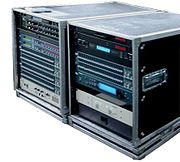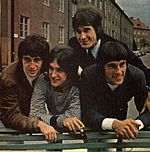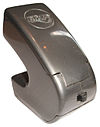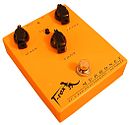- Effects unit
-
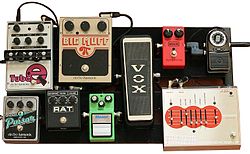 A pedalboard allows a performer to create a ready-to-use chain of multiple pedals. Signal chain order: tuner, compressor, octave generator, wah-wah pedal, overdrive, distortion, fuzz, EQ and tremolo.
A pedalboard allows a performer to create a ready-to-use chain of multiple pedals. Signal chain order: tuner, compressor, octave generator, wah-wah pedal, overdrive, distortion, fuzz, EQ and tremolo.
Effects units are electronic devices that alter how a musical instrument or other audio source sounds. Some effects subtly "color" a sound, while others transform it dramatically. Effects are used during live performances or in the studio, typically with electric guitar, keyboard and bass. While most frequently used with electric or electronic instruments, effects can also be used with acoustic instruments, drums and vocals.[1][2] Examples of common effects units include wah-wah pedals, fuzzboxes and reverb units.[3]
Effects are housed in amplifiers, table top units, "stompboxes" and "rackmounts", or they are built into the instruments themselves. A stompbox (or "pedal") is a small metal or plastic box placed on the floor in front of the musician and connected to his or her instrument. The box is typically controlled by one or more foot-pedal on-off switches and contains only one or two effects. A rackmount is mounted on a standard 19-inch equipment rack and usually contains several different types of effects.[4]
While there is currently no consensus on how to categorize effects, the following are seven common classifications: distortion, dynamics, filter, modulation, pitch/frequency, time-based and feedback/sustain.[5][6] Rock guitarists derive their signature sound or "tone" from their choice of instrument and effects.[7]
Contents
Formats (form factor)
 Boss ME-50 guitar multi-effects pedal
Boss ME-50 guitar multi-effects pedal
Effects units are available in a variety of formats or "form factors". A musician's choice of form factor is generally determined by the instrument he or she plays, the musical situation (recording or live performance) and what he or she can afford. Stompbox style pedals are usually the smallest, least expensive and most rugged type of effect. Rackmount devices are relatively expensive and offer a wider range of functions.[8] An effects unit can consist of analog or digital circuitry. During a live performance, the effect is plugged into the electrical "signal" path of the instrument. In the studio, the instrument or other sound-source's auxiliary output is patched into the effect.[9][10] Form factors are part of a studio or musician's outboard gear.[11]
 Ibanez Tube Screamer TS9 overdrive pedal
Ibanez Tube Screamer TS9 overdrive pedal
Stompboxes
Stompboxes, or effects pedals, are effects units designed to sit on the floor or a pedalboard and be turned on and off with the user's feet. They typically house a single effect. The simplest stompbox pedals have a single footswitch; one to three potentiometers for controlling the effect, gain or tone; and a single LED display to indicate whether the effect is on. The most complex stompbox pedals have multiple footswitches, eight to ten knobs, additional switches, and an alphanumeric display screen that indicates the status of the effect with short acronyms (e.g. DIST for "distortion").[8][12]
An "effects chain" or "signal chain" may be formed by connecting two or more stompboxes. Effect chains are typically created between a preamplifier (“preamp”) and the guitar amplifier. When a pedal is off or inactive, the electric audio signal coming in to the pedal is diverted onto a "bypass", resulting in a "dry" signal which continues on to other effects down the chain. In this way, the effects within a chain can be combined in a variety of ways without having to reconnect boxes during a performance.[13] A "controller" or "effects management system" allows for multiple effect chain loops to be created, so that one or several effects can be engaged or disengaged by tapping just one switch. The switches are usually organized in a row or a simple grid.
To preserve the clarity of the tone, it is most common to put compression, wah and overdrive pedals at the start of the chain; modulation (chorus, flanger, phase shifter) in the middle; and time-based units (delay/echo, reverb) at the end. When using many effects, unwanted noise and hum can be introduced into the sound. Some performers use a noise gate pedal at the end of a chain to reduce unwanted noise and hum introduced by overdrive units or vintage gear.[14]
Rackmounts
Rackmounted effects are built into a case designed to integrate into a 19-inch rack standard to the telecommunication and computing industries. A rackmount unit may contain electronic circuitry identical to a stompbox's, although its circuits are typically more complex. Unlike stompboxes, rackmounts usually have several different types of effects.[15]
Rackmounts are most commonly used in recording studios and "front of house" live sound mixing situations, though many musicians use them in lieu of stompboxes. Rackmounts are controlled by knobs or switches on their front panel, and often by a MIDI digital control interface. During live performances, a musician can operate rackmounted effects using a "foot controller".[16]
"Shock mount" racks are designed for musicians who are shipping gear on major tours. Devices that are less than 19 inches wide may use special "ear" adapters that allow them to be mounted on a rack.[17]
Built-in units
Effects are often incorporated into amplifiers and even some types of instruments. Electric guitar amplifiers typically have built-in reverb and distortion, while acoustic guitar and keyboard amplifiers tend to only have built-in reverb. Since the 2000s, guitar amplifiers began having built-in multi-effects units or digital modeling effects. Bass amplifiers are less likely to have built-in effects, although some may have a compressor/limiter or distortion.[18] Instruments with built-in effects include Hammond organs, electronic organs, electronic pianos and digital synthesizers.[19] Occasionally, acoustic-electric and electric guitars will have built-in effects.[20][21]
Multi-effects and tabletop units
A multi-effects device (also called a "multi-FX" device) is a single electronics effects pedal or rackmount device that contains many different electronic effects. Multi-FX devices allow users to "preset" combinations of different effects, allowing musicians quick on-stage access to different effects combinations.[22]
A tabletop unit is a type of multi-effects device that sits on a desk and is controlled manually. One such example is the Pod guitar amplifier modeler. Digital effects designed for DJs are often sold in tabletop models, so that the units can be placed alongside a mixer, turntables and CD scratching gear.[23]
History
In 1964 Dave Davies (second from left), lead guitarist of The Kinks, famously achieved a distorted sound on "You Really Got Me" by slashing the cones of his guitar amplifier with a razor blade.
Studio effects and early stand alone units
The earliest sound effects were strictly studio productions. In the mid to late 1940s, recording engineers and experimental musicians such as Les Paul began manipulating reel-to-reel recording tape to create echo effects and unusual, futuristic sounds. Microphone placement (“miking”) techniques were used in spaces with specially designed acoustic properties to simulate echo chambers.[24][25][26]
In 1948 DeArmond released the Trem-Trol, the first commercially available stand-alone effects unit. This device produced a tremolo by passing an instrument's electrical signal through a water-based electrolytic fluid.[27] Most stand-alone effects of the 1950s and early 60s such as the Gibson GA-VI vibrato unit and the Fender reverb box, were expensive and impractical, requiring bulky transformers and high voltages. The original stand-alone units were not especially in-demand as many effects came built into amplifiers. The first popular stand-alone was the 1958 Watkins Copicat, a relatively portable tape echo effect made famous by the British band, The Shadows.[28][29]Amplifiers
Amplifier built-ins were the first effects to be used regularly outside the studio by guitar players. From the late 1940s onward, the Gibson Guitar Corp. began including vibrato circuits in combo amplifiers. The 1950 Ray Butts EchoSonic amp was the first to feature the "slapback” echo sound, which quickly became popular with guitarists such as Chet Atkins, Carl Perkins, Scotty Moore, Luther Perkins, and Roy Orbison. By the 1950s, tremolo, vibrato and reverb were available as built-in effects on many guitar amplifiers. Both Premier and Gibson built tube-powered amps with spring reverb. Fender began manufacturing the tremolo amps Tremolux in 1955 and Vibrolux in 1956.[30]
Distortion was not an effect originally intended by amplifier manufacturers, but could often easily be achieved by “overdriving” the power supply in early tube amplifiers. In the 1950s, guitarists such as Willie Johnson of Howlin' Wolf, Paul Burlison of Johnny Burnette & The Rock N Roll Trio and Link Wray deliberately increased gain beyond its intended levels to achieve "warm" distorted sounds.[31] Wray's seminal 1958 recording "Rumble" inspired young musicians such as Pete Townshend of The Who, Jimmy Page of Led Zeppelin, Dave Davies of The Kinks, and Neil Young to explore distortion. Davies would famously doctor the speakers of his amp by slitting them with a razor blade to achieve an even grittier guitar sound on the 1964 song "You Really Got Me".[32] In 1966, the British company Marshall Amplification began producing the Marshall 1963, a guitar amplifier capable of producing the distorted "crunch" that rock musicians were starting to covet.[33][34]
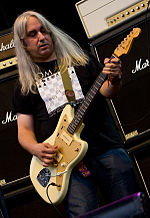 J Mascis of the American indie band Dinosaur Jr. helped to re-popularize analog stompboxes in the 1990s.[35]
J Mascis of the American indie band Dinosaur Jr. helped to re-popularize analog stompboxes in the 1990s.[35]
Stompboxes
The electronic transistor finally made it possible to cram the aural creativity of the recording studio into small, highly portable stompbox units. Transistors replaced vacuum tubes, allowing for much more compact formats and greater stability. The first transistorized guitar effect was the 1962 Maestro Fuzz Tone pedal, which became a sensation after its use in the 1965 Rolling Stones hit “(I Can't Get No) Satisfaction”.[36][37]
Warwick Electronics manufactured the first wah-wah pedal, The Clyde McCoy, in 1967 and that same year Roger Mayer issued the first octave effect, the Octavia.[38][39] In 1968, Univox began marketing its Uni-Vibe pedal, an effect designed by noted audio engineer Fumio Mieda that mimicked the odd phase shift and chorus effects of the Leslie rotating speakers used in Hammond organs. The pedals soon became favorite effects of guitarists Jimi Hendrix and Robin Trower. Upon first hearing the Octavia, Hendrix allegedly rushed back to the studio and immediately used it to record the guitar solos on "Purple Haze" and "Fire"[40] By the mid-1970s a variety of solid-state effects pedals including flangers, chorus pedals, ring modulators and phase shifters were available.[41][42]
In the 1980s, digitized rackmount units began replacing stompboxes as the effects format of choice. Often musicians would record "dry", unaltered tracks in the studio and effects would be added in post-production. The success of Nirvana's 1991 album Nevermind helped to re-ignite interest in stompboxes. Throughout the 1990s, musicians committed to a "lo-fi" aesthic such as J Mascis of Dinosaur Jr., Stephen Malkmus of Pavement and Robert Pollard of Guided by Voices continued to use non-digital (analog) effects pedals.[43]
Types
Distortion
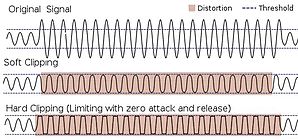 "Clipping" an instrument's audio signal produces distortion
"Clipping" an instrument's audio signal produces distortion
Distortion effects create "warm", "gritty" and "fuzzy" sounds by "clipping" an instrument's audio signal, which distorts the shape of its wave form and adds overtones. Distortion effects are sometimes called “gain” effects, as distorted guitar sounds were first achieved by increasing the electric power supply (i.e. gain) to tube amplifiers.[44][45][46]
Distortion and overdrive: Distortion and overdrive units re-shape or "clip" an audio signal's wave form so that it has flattened peaks, creating "warm" sounds by adding harmonics or "gritty" sounds by adding inharmonic overtones. In tube amplifiers, distortion is created by compressing the instrument's out-going electrical signal in vacuum tubes or "valves".[45][46] Distortion effects differ from overdrive effects in that they produce roughly the same amount of distortion at any volume. Overdrive units, much like tube amps, produce “clean” sounds at quieter volumes and distorted sounds at louder volumes.[47][48]
Distortion and overdrive effects: Boss DS-1 Distortion, Ibanez Tube Screamer, Marshall ShredMaster, MXR Distortion +, Pro Co RAT.Fuzz: A fuzz pedal or “fuzzbox” is a type of overdrive pedal that clips a sound-wave until it is nearly a squarewave, resulting in a heavily distorted or "fuzzy" sound.[46][49] Fuzzboxes also contain frequency multiplier circuitry to achieve an even harsher timbre by adding complex harmonics.[50][51] The Rolling Stones’ "(I Can't Get No) Satisfaction" greatly popularized the use of fuzz effects.[25]
Fuzz effects: Arbiter Fuzz Face, Electro-Harmonix Big Muff, Shin-ei Companion FY-2, Univox Super-Fuzz, Vox Tone Bender, Z.Vex Fuzz Factory.Dynamics
Also called volume and amplitude effects, dynamics effects modify the volume of an instrument. Dynamics effects were the first effects to be introduced to guitarists.[5]
Boost/volume pedal: A boost or "clean boost" amplifies the volume of an instrument by increasing the amplitude of its audio signal. These units are generally used for “boosting” volume during solos and preventing signal loss in long "effects chains". A guitarist switching from rhythm guitar to lead guitar may use a boost to increase the volume of his or her solo.[52]
Volume effects: Electro-Harmonix LPB-1, Fender Volume Pedal, MXR Micro Amp.Compressor: Compressors make loud sounds quieter and quiet sounds louder by decreasing or "compressing" the dynamic range of an audio signal.[53] A compressor is often used to stabilize volume and smooth a note’s "attack" by dampening its onset and amplifying its sustain. A compressor can also function as a limiter with extreme settings of its controls.[54]
Compressor effects: Keeley Compressor, MXR Dyna Comp.Noise gate: Noise gates eliminate “hum”, “hiss” and “static” by greatly diminishing the volume of sounds that fall below a set threshold. Noise gates are expanders, meaning unlike compressors they increase the dynamic range of an audio signal in order to make quiet sounds even quieter.[53] If used with extreme settings along with reverb, they can create unusual sounds, such as the gated drum effect used in 1980s pop songs, a style popularized by the Phil Collins song "In the Air Tonight".[55][56]
Noise gate effects: Boss NS-2 Noise Suppressor.Filter
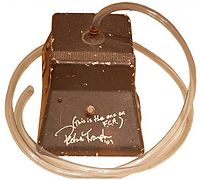 Peter Frampton's Talk box
Peter Frampton's Talk box
Filter effects alter the frequency content of an audio signal that passes through them by either boosting or weakening specific frequencies or frequency regions.
Equalizer: An equalizer is a set of linear filters that strengthen ("boost") or weaken ("cut") specific frequency regions. Stereos often have equalizers that adjust bass and treble.[57] Audio engineers use highly sophisticated equalizers to eliminate unwanted sounds, make an instrument or voice more prominent, and enhance particular aspects of an instrument's tone.[58]
Equalizer effects: Boss GE-7 Equalizer.Talk box: A talk box directs the sound from a guitar or synthesizer into the mouth of a performer, allowing him or her to shape the sound into vowels and consonants. The modified sound is then picked up by a microphone. In this way the guitar is able to “talk”. Some famous uses of the talkbox include Bon Jovi’s “Living on a Prayer”, Stevie Wonder's “Black Man” and Peter Frampton's "Show Me the Way".[59][60]
Talk boxes: Dunlop HT1 Heil Talk Box, Rocktron Banshee.Wah-wah: A wah-wah pedal creates vowel-like sounds by altering the frequency spectrum produced by an instrument—i.e. how loud it is at each separate frequency—in what is known as a spectral glide or "sweep".[61] The device is operated by a foot treadle that opens and closes a potentiometer. Wah-wah pedals are often used by funk and psychedelic rock guitarists.[62]
Wah effects: Dunlop Cry Baby, Morley Power Wah, Musitronics Mu-Tron III.Modulation
Modulation effects combine multiple audio signals in order to create sounds with unusual tonal properties. Some modulation effects mix ("modulate") an instrument's audio signal with a signal generated by the effect called a carrier wave.[63] Other modulation effects split an instrument's audio signal in two, altering one portion of the signal and mixing it with the unaltered portion.[64]
Chorus: Chorus pedals mimic the effect choirs and string orchestras produce naturally by mixing sounds with slight differences in timbre and pitch. A chorus effect splits the instrument-to-amplifier audio signal, adding a slight delay and frequency variations or “vibrato” to part of the signal while leaving the rest unaltered.[64][65] A well-known usage of chorus is the lead guitar in “Come As You Are” by Nirvana.[54]
Chorus effects: Boss CE-1 Chorus Ensemble, Electro-Harmonix Small Clone, TC Electronic Stereo Chorus.Flanger: A flanger creates a "jet plane" or "spaceship" sound, simulating a studio effect produced by recording a track on two synchronized tapes and periodically slowing one tape by pressing the edge of its reel (the “flange”). When the two tapes' audio signals are later mixed, a comb filter effect can be heard. Flanger units add a variably delayed version of the audio signal to the original or signal, creating a comb filter or Doppler effect.[66][67] Some famous uses of flanger effects include "Walking on the Moon" by The Police and "Barracuda" by Heart.[68][69]
Flanger effects: Electro-Harmonix Electric Mistress, MXR Flanger.Phaser: A phaser or "phase shifter" creates a slight rippling effect—amplifying some aspects of the tone while diminishing others—by splitting an audio signal in two and altering the phase of one portion. Two well-known examples of phaser are keyboard parts on Billy Joel’s “Just the Way You Are” and Paul Simon's "Slip Slidin' Away".[70]
Phase shift effects: Electro-Harmonix Small Stone, MXR Phase 90, Univox Uni-Vibe.Ring modulator: A ring modulator produces a resonant, metallic sound by mixing an instrument's audio signal with a carrier wave generated by the device's internal oscillator. The original sound wave is suppressed and replaced by a "ring" of inharmonic higher and lower pitches or "sidebands".[63][71] A notable use of ring modulation is the guitar in the Black Sabbath song "Paranoid".[72]
Ring modulator effects: moogerfooger MF-102 Ring Modulator.Tremolo: A tremolo effect produces a slight, rapid variation in the volume of a note or chord. The "tremolo effect” should not be confused with the misleadingly-named "tremolo bar", a device on a guitar bridge which allows the player to create a vibrato or “pitch-bending” effect. In transistorized effects, a tremolo is produced by mixing an instrument's audio signal with a sub-audible carrier wave in such a way that generates amplitude variations in the sound wave.[73][74] The guitar intro in the Rolling Stones' "Gimme Shelter" features a tremolo effect.[75]
Tremolo effects: Demeter TRM-1 Tremulator, Fender Tremolux.Vibrato: Vibrato effects produce slight, rapid variations in pitch, mimicking the fractional semitone variations produced naturally by opera singers and violinists when prolonging a single note. Vibrato effects often allow the performer to control the rate of the variation as well as the difference in pitch (e.g. “depth”). A vibrato with an extreme "depth" setting (e.g., half a semitone or more) will produce a dramatic, ululating sound. In transistorized effects, vibrato is produced by mixing an instrument's audio signal with a carrier wave in such a way that generates frequency variations in the sound wave.[74] Guitarists often use the terms "vibrato" and "tremolo" misleadingly. A so-called "vibrato unit" in a guitar amplifier actually produces tremolo, while a "tremolo arm" or “whammy bar” on a guitar produces vibrato.[76][77] The guitar intro on Blonde Redhead's "In Particular" features a pronounced vibrato effect.
Vibrato effects: Boss VB-2 Vibrato.Pitch/frequency
Pitch/frequency effects modify pitch by altering the frequency of a sound wave or adding new harmonies.
Pitch shifter and harmonizer: A pitch shifter raises or lowers (e.g. "transposes") each note a performer plays by a pre-set interval. For example, a pitch shifter set to increase the pitch by a fourth will raise each note four diatonic intervals above the notes actually played. Simple pitch shifters raise or lower the pitch by one or two octaves, while more sophisticated devices offer a range of interval alterations.
A harmonizer is a type of pitch shifter that combines the altered pitch with the original pitch to create a two or more note harmony. Some hamonizers are able to create chorus-like effects by adding very tiny shifts in pitch.[78]
Pitch shift effects: DigiTech Whammy, Electro-Harmonix POG.Time-based
Time-based effects delay the sound signal or adds echos.
Delay/echo: Delay/echo units produce an echo effect by adding a duplicate instrument-to-amplifier electrical signal to the original signal at a slight time-delay. The effect can either be a single echo called a “slap” or “slapback,” or multiple echos. A well-known use of delay is the lead guitar in the U2 song "Where the Streets Have No Name".[79]
Delay effects: Boss DD-3 Digital Delay, Electro-Harmonix Memory Man, Line 6 DL4 Delay Modeler, Roland RE-201.Looper pedal: A looper pedal or "phrase looper" allows a performer to record and later replay a phrase or passage from a song. Loops can be created on the spot during a performance or they can be pre-recorded. Some units allow a performer to layer multiple loops. The first loop effects were created with reel-to-reel tape using a tape loop. High-end boutique tape loop effects are still used by some studios who want a vintage sound. Digital loop effects recreate this effect using an electronic memory.[80]
Looper effects: Boss RC-30 Loop Station.Reverb: Reverb units simulate sounds produced in an echo chamber by creating a large number of echoes that gradually fade or "decay". A plate reverb system uses an electromechanical transducer to create vibrations in a plate of metal. Spring reverb systems, which are often used in guitar amplifiers, use a transducer to create vibrations in a spring. Digital reverb effects use various signal processing algorithms to create the reverb effect, often by using multiple feedback delay circuits. Rockabilly and surf guitar are two genres that make heavy use of reverb.[81]
Reverb effects: Electro-Harmonix Holy Grail, Fender Reverb Unit.Feedback/sustain
Audio feedback as a desired guitar effect has been pioneered by guitarists such as Jimi Hendrix. It is generated by playing an instrument directly in front of an amplifier set to a high volume turning the tone into a feedback tone with infinite sustain. Typically, these feedback tones turn quickly from basic notes into overtones. It can be difficult to get feedback conditions, because it depends on the sound volume and on the position of the guitar relative to the loudspeaker[82][83]
The EBow, a handheld pickup/string driver, uses two small coils. One coil has a permanent magnet. It picks up the string vibration similar to a guitar pickup. The electrical signal is amplified for driving the second coil which acts as a magnetic string driver to vibrate the string. By this feedback loop a bow-like infinitely sustained sound is generated. The Ebow can drive one string at the same time. Latest Ebow models contain a mode switch which allows the player to change from basic note to overtones feedback sustain [62].
Other magnetic string drivers use the guitar pickup signal as input. Guitar built-in devices such as the Sustainiac Sustainer and the Fernandes Sustainer create feedback sustain with a string driver mounted in the guitar.
Many compressor pedals are often also marketed as "sustainer pedals". As a note is sustained, it loses energy and volume due to diminishing vibration in the string. The compressor pedal boosts its electrical signal to the specified dynamic range, slightly prolonging the duration of the note.[84]
Other effects
Envelope follower: An envelope follower activates an effect once a designated volume is reached. One effect that uses an envelope follower is the "auto-wah", which produces a "wah" effect depending on how loud or soft the notes are being played.[85][86]
Guitar amplifier modeling: Amplifier modeling is a digital effect that replicates the sound of various amplifiers, most often analog “tube” amps. Sophisticated modeling effects can simulate speaker cabinets and miking techniques. A rotary speaker simulator mimics the doppler sound of a vintage Leslie speaker system by replicating its volume and pitch modulations, overdrive capacity and phase shifts.[87]
Pitch correction/vocal effects: Pitch correction effects use signal-processing algorithms to re-tune faulty intonation in a vocalist's performance.[88]
Simulators: Simulators enable electric guitars to mimic the sound of other instruments such as acoustic guitar, electric bass and sitar. Pick up simulators used on guitars with single-coil pick ups replicate the sound of guitars with humbucker pick ups, or vice-versa. A de-fretter is a bass guitar effect that simulates the sound of a fretless bass. The effect uses an envelope-controlled filter and voltage-controlled amplifier to “soften” a note's attack both in volume and timbre.[89]
Boutique pedals
Boutique pedals are designed by smaller, independent companies and are typically produced in limited quantities. Some may even be hand-made. These pedals are mainly distributed online or through mail-order, or sold in a few music stores.[90] They are often more expensive than mass-produced pedals[91] and offer non-standard features such as true-bypass switching, higher-quality components, innovative designs, and hand-painted artwork. Some boutique companies focus on re-creating classic or vintage effects.[92]
Some boutique pedal manufacturers include: Analog Man, BJFE, Pete Cornish, Emlyn Crowther, Death By Audio, Devi Ever, Robert Keeley, Roger Linn, Lovetone, Roger Mayer, Strymon, T-Rex Engineering, ToadWorks and Z.Vex Effects.Effects unit modification
There is also a niche market for modifying or "modding" effects. Typically, vendors provide either custom modification services or sell new effects pedals which have been modified. The Ibanez Tube Screamer, Boss DS-1, Pro Co RAT and DigiTech Whammy are some of the most often-modified effects.[93][94] Common modifications include value changes in capacitors or resistors, adding true-bypass so that the effect's circuitry is no longer in the signal path, substituting higher-quality components, replacing the unit's original operational amplifiers (op-amps), or adding functions to the device such as allowing additional control of some factor or adding an additional output jack.[93][95][96]
Tributes by musicians
 The garage rock revival band The Fuzztones, seen here in a Barcelona concert, are named after an influential 1960s-era fuzz pedal (the Fuzztone).
The garage rock revival band The Fuzztones, seen here in a Barcelona concert, are named after an influential 1960s-era fuzz pedal (the Fuzztone).
Effects and effects units—stompboxes in particular—have been celebrated by pop and rock musicians in album titles, songs and band names. The Big Muff, a classic fuzzbox manufactured by Electro-Harmonix,[97] is commemorated by the Depeche Mode song "Big Muff" and the Mudhoney EP Superfuzz Bigmuff. Lyrics to Super Furry Animals' "Play It Cool" mention another Electro-Harmonix pedal, the Electric Mistress flanger.[98][99] The Nine Inch Nails song "Echoplex" is titled after Maestro's vintage echo unit.[100] Other songs that reference effects include "Interstellar Overdrive" by Pink Floyd, "Wah-Wah" by George Harrison, and "Stomp Box" by They Might Be Giants. Joy Division's "Digital" was inspired by engineer/producer Martin Hannett's AMS digital delay unit.[101] We've Got a Fuzzbox and We're Gonna Use It were an all-female British band from the 1980s,[102] and The Fuzztones were a 1980s garage rock revival band.[103]
Other pedals and rackmount units
Not all stompboxes and rackmounts are effects. Strobe tuner pedals indicate whether a guitar string is too sharp or flat.[104] A footswitch pedal such as the "A/B" pedal route a guitar signal to an amplifier or enable a performer to switch between two guitars. Guitar amplifiers and electronic keyboards may have switch pedals for turning built-in effects on and off.[105] Some musicians who use rackmounted effects or laptops employ a MIDI controller pedalboard or armband remote controls to trigger sound samples, switch between different effects or control effect settings.[106][107][108]
See also
- Audio effects
- Outboard gear — for more generic article
- Sound effect
- Audio signal processing
- Acoustic wave — for natural audio effects
Technologies- Digital signal processor
- Linear filter
- Non-linear filter
- Frequency divider
- Frequency mixer
- Frequency multiplier
References
- ^ Horne, Greg (2000). Complete Acoustic Guitar Method: Mastering Acoustic Guitar c. Alfred Music. p. 92. http://books.google.com/books?id=cHALQ_CO5P0C.
- ^ Yakabuski, Jim (2001). Professional Sound Reinforcement Techniques: Tips and Tricks of a Concert Sound Engineer. Hal Leonard. p. 139. http://books.google.com/books?id=QwcLdjCCXHkC.
- ^ Clement, Vivian (2007). How to Succeed As a Female Guitarist: The Essential Guide for Working in a Male-dominated Industry. Alfred Music. p. 30. http://books.google.com/books?id=FHOskiubkx0C.
- ^ Clement, V (2007). How to Succeed As a Female Guitarist. Alfred Music. p. 30.
- ^ a b "The Art of the Stompbox". The Museum of Making. 2010. http://www.museumofmakingmusic.org/stompbox/index.php/home/categories-of-effects. Retrieved 13 September 2010.
- ^ "Guitar effects". Trip Atlas. http://tripatlas.com/Guitar_effects#Samples. Retrieved 18 September 2010.
- ^ Brewster, David M. (2003), Introduction to Guitar Tone and Effects: A Manual for Getting the Sounds from Electric Guitars, Amplifiers, Effects Pedals and Processors, Hal Leonard, p. 14, http://books.google.com/books?id=q99-bY3cL8YC&pg=PA63&dq=rock+guitar+tone&hl=en&ei=JGzFTdSoF474sAOA_uCZAQ&sa=X&oi=book_result&ct=result&resnum=2&ved=0CFUQ6AEwAQ#v=onepage&q=rock%20guitar%20tone&f=false
- ^ a b Clement, V (2007). How to Succeed As a Female Guitarist, Alfred Music. p. 30-31.
- ^ Gibson, Bill (2007). The Ultimate Live Sound Operator's Handbook. Hal Leonard. p. 366. http://books.google.com/books?id=r86J_aNNReEC.
- ^ McCormick, Tim; Rumsey, Francis (2009). Sound and Recording. Focal Press. p. 131. http://books.google.com/books?id=8JH6Z5c6-OUC&dq=%22auxiliary+output%22+recording+effects&source=gbs_navlinks_s.
- ^ Editors, Guitar Player Magazine (2001). How to Play Guitar: The Basics & Beyond. Hal Leonard. p. 82.
- ^ Mangum, Eric; Stubbs, Dean (2000). Dod Presents 100 Superstar Guitar Sounds on a Stompbox Budget. Hal Leonard. p. 8.
- ^ Egnater, Bruce "Bruce Egnater on Effects Loops" Guitar Player, December, 2009.
- ^ Rogers, Jerry. Your Band's First Gig: Getting The Sound Right. http://books.google.com/books?id=tSXSg-_o_OcC. Retrieved 10 September 2010.
- ^ Ashton, Adrian (2006). The Bass Handbook. Hal Leonard. pp. 91–92. http://books.google.com/books?id=I97xJYZC2lIC&pg=PA92&dq=rackmount+ear&hl=en&ei=xXXETePwII-8sQP9o_HrAQ&sa=X&oi=book_result&ct=result&resnum=3&ved=0CGoQ6AEwAg#v=onepage&q=rack%20mount%20ear&f=false.
- ^ Levitin, Dan (1992). From Demo Tape to Record Deal: Handy Guide. Alfred Music. p. 26. ISBN 0882844946. http://books.google.com/books?id=IxeGcwKrJUUC&pg=PA26&dq=rack+foot+controller&hl=en&ei=SHLETfXzCoqesQO9sYnrAQ&sa=X&oi=book_result&ct=result&resnum=10&ved=0CJQBEOgBMAk#v=onepage&q=rack%20foot%20controller&f=false.
- ^ Ashton, Adrian (2006). The Bass Handbook. Hal Leonard. p. 92. http://books.google.com/books?id=I97xJYZC2lIC&pg=PA92&dq=rackmount+ear&hl=en&ei=xXXETePwII-8sQP9o_HrAQ&sa=X&oi=book_result&ct=result&resnum=3&ved=0CGoQ6AEwAg#v=onepage&q=rack%20mount%20ear&f=false.
- ^ Eiche. Jon; Fliegler, Ritchie (1993) Amps!: The Other Half of Rock 'n' Roll, Hal Leonard. p. 25, 40, 52, 74.
- ^ Reid, Gordon (January 2004), "Synthesizing Hammond Organ Effects: Part1", Sound on Sound, http://www.soundonsound.com/sos/jan04/articles/synthsecrets.htm, retrieved 12 September 2010
- ^ Pinksterboer, Hugo (2001), Tipbook: Acoustic Guitar, Hal Leonard, p. 51, http://books.google.com/books?id=xIT_PpFqz_4C
- ^ Brewster, David M. (2003), Introduction to Guitar Tone and Effects: A Manual for Getting the Sounds from Electric Guitars, Amplifiers, Effects Pedals and Processors, Hal Leonard, p. 7, http://books.google.com/books?id=q99-bY3cL8YC
- ^ Hunter, Dave (2004). Guitar Effects Pedals: The Practical Handbook. Hal Leonard. p. 125.
- ^ Bartlett, Bruce; Bartlett, Jenny (2008). Practical Recording Techniques: The Step-by-step Approach to Professional Audio Recording. Focal Press. p. 226.
- ^ Tianen, Dave (August 13, 2009). "The Wizard Of Waukesha". http://www.pbs.org/wnet/americanmasters/episodes/les-paul/chasing-sound/100/. Retrieved 13 September 2010.
- ^ a b "The Art of the Stompbox". The Museum of Making. 2010. http://www.museumofmakingmusic.org/stompbox/index.php/home/categories-of-effects. Retrieved 13 September 2010.
- ^ Roads, Curtis (1996). The Computer Music Tutorial. MIT Press. pp. 437, 476. http://books.google.com/books?id=nZ-TetwzVcIC.
- ^ Chester, Paul. "Acoustic Guitar - Early Pickups". http://www.paulvernonchester.com/VintagePickups.htm. Retrieved 3 January 2011.
- ^ Hunter, D (2004). Guitar Effects Pedals: The Practical Handbook. Hal Leonard. p. 11-12.
- ^ "THE WATKINS/WEM COPICAT" 13 September 2010
- ^ Hunter, D (2004). Guitar Effects Pedals: The Practical Handbook. Hal Leonard. p. 11-13.
- ^ Dave, Rubin (2007). Inside the Blues, 1942 to 1982. Hal Leonard. p. 61. http://books.google.com/books?id=0amzAiwBmOcC.
- ^ Gracyk, Theodore (1996). Rhythm and Noise: An Aesthetics of Rock. I.B.Tauris. pp. 121–123. http://books.google.com/books?id=HUB7Wu-Kn1QC.
- ^ A. J., Millard (2004). The Electric Guitar: A History of an American Icon. JHU Press. p. 136. http://books.google.com/books?id=zUlt7Q71_ssC.
- ^ Doyle, Michael (1993). The History of Marshall: The Illustrated Story of "The Sound of Rock". Hal Leonard Corporation. pp. 28–33. ISBN 0793525098. http://books.google.com/books?id=E90tMBs9_FEC&pg=PA20&dq=marshall+amplifier+1965&hl=en&ei=JaPGTbf1M4WCsQPY6fnrAQ&sa=X&oi=book_result&ct=result&resnum=2&ved=0CGkQ6AEwAQ#v=onepage&q=overdrive&f=false.
- ^ "J Mascis: Cutting Through the Fog". http://gc.guitarcenter.com/interview/jmascis/. Retrieved July 2011.
- ^ "The Art of the Stompbox". 2010. http://www.museumofmakingmusic.org/stompbox/index.php/home/history. Retrieved 13 September 2010.
- ^ "FuzzEffect: The Fuzz Story and Photos". http://www.fuzzeffect.com/. Retrieved 13 September 2010.
- ^ Drozdowski, Ted (June, 30 2008). "The Accidental Birth of the Wah-wah Pedal and How It Became the Signature Sound of Psychedelic Rock". http://www.gibson.com/en-us/Lifestyle/Features/the-accidental-birth-of-the-wa/. Retrieved 13 September 2010.
- ^ Mayer, Roger. "Octavia". http://www.roger-mayer.co.uk/octavia.htm. Retrieved 13 September 2010.
- ^ Molenda, Mike; Pau, Les (2007). The Guitar Player Book: 40 Years of Interviews, Gear, and Lessons from the World's Most Celebrated Guitar Magazine. Hal Leonard. p. 222. http://books.google.com/books?id=zu3owmYkpZ0C.
- ^ Hunter, D (2004). Guitar Effects Pedals: The Practical Handbook. Hal Leonard. p. 11-15.
- ^ Thomas E. Oberheim (May 1970). "A Ring Modulator Device for the Performing Musician". AES Convention 38: 708.
- ^ Atria, Travis (March 6, 2008), "Stephen Malkmus – Talks Real Emotional Trash", Glide Magazine, http://www.glidemagazine.com/articles/53170/stephen-malkmus-talks-real-emotional-trash.html, retrieved 13 September 2010
- ^ Menasche, Emile D. (2007). Home Studio Clinic: A Musician's Guide to Professional Recording. Hal Leonard. p. 80. http://books.google.com/books?id=NNg_FSWz9FcC&pg=PA80&dq=gain+effects+distortion&hl=en&ei=-eHGTbLuOIGssAP37bioAQ&sa=X&oi=book_result&ct=result&resnum=1&ved=0CDMQ6AEwAA#v=onepage&q=gain%20effects%20distortion&f=false.
- ^ a b Ross, Michael (1998). Getting Great Guitar Sounds. Hal Leonard. p. 39. http://books.google.com/books?id=CddgbKkAoxYC&pg=PA39&dq=distortion+overdrive+tube+compress+transistor&hl=en&ei=syGVTMCFK4_2tgPhkPnACg.
- ^ a b c Aikin, Jim (2004). Power Tools for Synthesizer Programming, Hal Leonard. p. 171.
- ^ Zölzer, Udo; Amatriain, Xavier (2002). DAFX: Digital Audio Effects. John Wiley and Sons. p. 117. http://books.google.com/books?id=h90HIV0uwVsC.
- ^ Brewster, David M. (2001), Introduction to Guitar Tone and Effects: A Manual for Getting the Sounds from Electric Guitars, Amplifiers, Effects Pedals and Processors, Hal Leonard, p. 18, http://books.google.com/books?id=q99-bY3cL8YC&pg=PA18&dq=overdrive+tube+amplifier&hl=en&ei=u2fETZG6Jo_msQO85KzCAQ&sa=X&oi=book_result&ct=result&resnum=1&sqi=2&ved=0CGoQ6AEwAA#v=onepage&q=overdrive%20tube%20amplifier&f=false
- ^ Platt, Charles (2009). MAKE: Electronics: Learning Through Discovery O'Reilly Media. p. 257.
- ^ Holmes, Thom (2006). The Routledge Guide to Music Technology. CRC Press. p. 177. ISBN 0415973244. http://books.google.com/books?id=iH1tZ64riu4C&pg=PA117&lpg=PA117&dq=fuzz+%22frequency+multiplier%22&source=bl&ots=s0_1nPNHTo&sig=ASmZQUv2e8-IVM_hb-TKCjUHOh4&hl=en&ei=h8zATd7AGY7msQPpuMjgBw&sa=X&oi=book_result&ct=result&resnum=2&ved=0CC4Q6AEwAQ#v=onepage&q=%22frequency%20multiplier%22&f=false.
- ^ Manning, Peter (2004). Electronic and Computer Music. Oxford University Press US. p. 170. ISBN 0195144848. http://books.google.com/books?id=P2dClS4LdPQC&pg=PA170&dq=guitar+%22frequency+multiplier%22&hl=en&ei=OczATc2IHIr2swOlrbzgBw&sa=X&oi=book_result&ct=result&resnum=1&ved=0CEAQ6AEwAA#v=onepage&q=%22frequency%20multiplier%22&f=false.
- ^ Hunter, Dave (2004). Guitar Effects Pedals: The Practical Handbook. Hal Leonard. p. 23.
- ^ a b Reese, David; Gross, Lynne; Gross, Brian (2009). Audio Production Worktext: Concepts, Techniques, and Equipment. Focal Press. pp. 149. ISBN 0240810988. http://books.google.com/books?id=NH1Q0BI2YPcC.
- ^ a b Hunter, D (2004). Guitar Effects Pedals: The Practical Handbook. Hal Leonard. p. 23.
- ^ Louie, Gary J.; White, Glenn D. (2005). The Audio Dictionary, University of Washington Press. p. 171.
- ^ Flans, Robyn "Classic Tracks: Phil Collins' 'In the Air Tonight' ", Mix, May 1, 2005.
- ^ Rudolph, Thomas; Leonard, Vincent (2001) Recording in the Digital World: Complete Guide to Studio Gear and Software, Hal Leonard . p. 192.
- ^ Strong, Jeff (2005). PC Recording Studios for Dummies. For Dummies. p. 25. http://books.google.com/books?id=4-2SfnghnYwC&dq=pc+recording+studios+for+dummies&source=gbs_navlinks_s.
- ^ Dyers, Jon (March 21, 2008). "The Talkbox Will Never Die: A Talkbox Playlist". Dyers. http://www.dyers.org/blog/archives/2008/03/21/the-talkbox-will-never-die-a-talkbox-playlist/. Retrieved 20 September 2010.
- ^ McCarron, Brett. "The Talkbox FAQ". http://www.blamepro.com/talkbox.htm#top. Retrieved 10 September 2010.
- ^ Denton, Dailey J. (2011). Electronics for Guitarists. Springer. p. 183. http://books.google.com/books?id=PPg5_lPQJyMC&pg=PA185&dq=wah+frequency+sweep&hl=en&ei=kCLETbnXOYG8sQOu75GsAQ&sa=X&oi=book_result&ct=result&resnum=2&ved=0CC8Q6AEwAQ#v=onepage&q=wah%20frequency%20sweep&f=false.
- ^ a b Schneider, John (1985). The Contemporary Guitar, University of California Press. p. 202.
- ^ a b Zölzer, Udo; Amatriain, Xavier (2002). DAFX: Digital Audio Effects. John Wiley and Sons. p. 76. http://books.google.com/books?id=h90HIV0uwVsC.
- ^ a b Coulter, Doug. (2001). Digital Audio Processing, Focal Press. p. 271.
- ^ Perkins, Chad (2009). The After Effects Illusionist: All the Effects in One Complete Guide. Focal Press. p. 37. ISBN 0240811453. http://books.google.com/books?id=qsvgDeyrz-0C&pg=PA37&dq=chorus+signal+delay&hl=en&ei=LWzETZOdKovUtQPcvqSnAQ&sa=X&oi=book_result&ct=result&resnum=3&ved=0CDUQ6AEwAg#v=onepage&q=chorus%20signal%20delay&f=false.
- ^ Kurasaki, Kurt (2005). Power Tools for Reason 3.0: Master the World's Most Popular Virtual Studio. Hal Leonard. pp. 169. http://books.google.com/books?id=nPkBCZ1F7kAC&pg=PA169&dq=flanger+effects+modulation&hl=en&ei=ypy8TayRMI64sAPOn9HYBQ&sa=X&oi=book_result&ct=result&resnum=5&ved=0CEwQ6AEwBDgK#v=onepage&q=flanger%20effects%20modulation&f=false.
- ^ Louie, G; White, G (2005). The Audio Dictionary, University of Washington Press. p. 153.
- ^ "Electro Harmonix Deluxe Electric Mistress Review". Internet Guitar Database. http://www.igdb.co.uk/pages/reviews/effect/electro_harmonix/deluxe_electric_mistress.htm. Retrieved 19 September 2001.
- ^ Brewster, David M. (2001), Introduction to Guitar Tone and Effects: A Manual for Getting the Sounds from Electric Guitars, Amplifiers, Effects Pedals and Processors, Hal Leonard, p. 29, http://books.google.com/books?id=q99-bY3cL8YC
- ^ Louie, G; White, G. (2005). The Audio Dictionary, University of Washington Press. p. 288.
- ^ Moog, Robert (1984), "Pitch Blending, Modulation, and Expression", Synthesizer technique, Keyboard Synthesizer Library, Vol. 2, Hal Leonard, p. 52, ISBN 0881882909, http://books.google.com/books?id=IQrOFoWL0T4C&pg=PA53&dq=%22pitch+shift%22+sideband&hl=en&ei=WqvBTcXVFsPjiALx3cmtAw&sa=X&oi=book_result&ct=result&resnum=1&ved=0CDYQ6AEwAA#v=onepage&q&f=false
- ^ McNamee, David "Hey, What's That Sound: Ring Modulators", The Guardian, London, November 9, 2009.
- ^ Hartman, W. M. (March 19, 1979), The Electronic Music Synthesizer and the Physics of Music, Michigan State University, http://www.pa.msu.edu/acoustics/ajpsynth.pdf, retrieved May 2011
- ^ a b Holmes, Thomas (2008), Electronic and Experimental Music: Technology, Music, and Culture, Taylor & Francis, p. 198, ISBN 0415957818, http://books.google.com/books?id=hCthQ-bec-QC&pg=PA198&lpg=PA198&dq=vibrato+%22carrier+wave%22+%22carrier+signal%22&source=bl&ots=fMKnKF-CUV&sig=0jPhzdDWm9PQghiSVRgrb2_54Pc&hl=en&ei=dEXATYPtPOTgiAKAr6WhAw&sa=X&oi=book_result&ct=result&resnum=2&ved=0CBwQ6AEwAQ#v=onepage&q=vibrato%20%22carrier%20wave%22%20%22carrier%20signal%22&f=false
- ^ Trolet, Jean-Pierre. "Rolling Stones – Gimme Shelter tab". http://www.guitaretab.com/r/rolling-stones/16342.html. Retrieved 9 September 2010.
- ^ Mangum, E; Stubbs, D (2000). Dod Presents 100 Superstar Guitar Sounds on a Stompbox Budget. Hal Leonard. p. 94.
- ^ Fischer, Peter (2000), Rock Guitar Secrets, Mel Bay. p. 164.
- ^ Izhaki, Roey (2007). Mixing Audio: Concepts, Practices and Tools, Focal Press. p. 470.
- ^ Hubner, David; Runstein, Robert (2009). Modern Recording Techniques, Focal Press. p. 508.
- ^ Hopper, Jessica (2009). The Girl’s Guide to Rocking Out. Workman Publishing. p. 34. http://books.google.com/books?id=RwzQe_h-OjQC.
- ^ Hubner, D; Runstein, R (2009). Modern Recording Techniques, Focal Press. p. 508.
- ^ Wright, Ed (2007). Left-Handed History of the World, Murdoch Books. p. 209.
- ^ Amelar, Chris (1997). The Guitar F/X Cookbook, Hal Leonard. p. 41.
- ^ Hunter, Dave (2004). Guitar Effects Pedals: The Practical Handbook. Hal Leonard. p. 25.
- ^ White, G, Louie, G (2005). The Audio Dictionary Instruments. University of Washington Press. p. 138. http://books.google.com/books?id=DulVm8t88QkC&dq=flanger+jet+plane&source=gbs_navlinks_s.
- ^ Hopper, J (2009). The Girl’s Guide to Rocking Out. Workman Publishing. p. 33. http://books.google.com/books?id=RwzQe_h-OjQC.
- ^ Bartlett, B; Bartlett, J (2008). Practical Recording Techniques: The Step-by-step Approach to Professional Audio Recording. Focal Press. p. 226.
- ^ Brice, Richard (2001). Music Engineering, Newnes. p. 413.
- ^ "Boss GT-8 Floor Guitar Effects Processor". http://www.kellyindustries.com/guitars/boss_gt8.html. Retrieved 10 September 2010.
- ^ "Batt-O-Meter : Where to Buy". •Keith McMillen Instruments. http://www.keithmcmillen.com/products/batt-o-meter/whereToBuy.php. Retrieved 18 September 2010.
- ^ Hunter, Dave (2004). Guitar Effects Pedals: The Practical Handbook. Hal Leonard. p. 204. http://books.google.com/books?id=7DjYrk7Vap4C.
- ^ "What is True Bypass?". Dunlop News. http://www.jimdunlop.com/blog/?p=384. Retrieved 18 September 2010.
- ^ a b Moraga, Christian. "Mod.It.Yourself (M.I.Y) Parts 1 – 3". Effects Bay. http://www.effectsbay.com/2009/11/mod-it-yourself-m-i-y-part-1/. Retrieved 18 September 2010.
- ^ "Modifications". cubisteffects. http://www.cubisteffects.com/category/modifications/. Retrieved 18 September 2010.
- ^ "Selected Stompbox Schematics". DIY Stompbox. http://www.diystompboxes.com/pedals/schematics.html. Retrieved 18 September 2010.
- ^ Platt, Charles "Stompbox Basics: Tremolo and Fuzz" MAKE Magazine, September, 9 2008.
- ^ "Big Muff Pi Distortion/Sustainer". Electro-Harmonix. http://www.ehx.com/products/big-muff-pi. Retrieved 18 September 2010.
- ^ "Deluxe Electric Mistress Analog Flanger". Electro-Harmonix. http://www.ehx.com/products/deluxe-electric-mistress. Retrieved 18 September 2010.
- ^ "Play It Cool Lyrics – Super Furry Animals". http://www.superfurry.org/info.php?q=playitcool&t=lyrics. Retrieved 18 September 2010.
- ^ "Maestro Echoplex". http://www.superpage.com/riffs/desc_maestro_echoplex.html. Retrieved 18 September 2010.
- ^ Barker, David (2007), 33 1/3 Greatest Hits, Volume 1, Continuum International, p. 112, http://books.google.com/books?id=7v7wJqhaBhoC
- ^ "Get yourself a Vix fix", BBC, 17 February 2009
- ^ Carlson, Matt; Leggett, Steve. "The Fuzztones". AMG. http://www.allmusic.com/artist/p4326. Retrieved 18 September 2010.
- ^ Chappell, Jon; Phillips, Mark (2005). Guitar for Dummies, For Dummies. p. 291.
- ^ Chappell, Jon; Phillips, Mark (2005). Guitar for Dummies, For Dummies. p. 187.
- ^ Delaney, Martin (2007). Ableton Live 6 Tips and Tricks. PC Publishing. p. 5. http://books.google.com/books?id=3Sn4FaSVE-4C.
- ^ Kahn, Scott (March 6, 2006), "Racks 201: MIDI Foot Controllers", Music Players, http://www.musicplayers.com/tutorials/guitars/2006/0306_MIDIFootControllers.php, retrieved 18 September 2010
- ^ Armband Controller for Effects Chain, October 23, 2010, http://www.effectsbay.com/2010/11/armband-controller-for-effects-chain/, retrieved 1 March 2011
External links
- A Guide to Multi Effect Pedals.
- History and Photos of Vintage Fuzz Pedals.
- 50 of the Greatest Stompboxes
Music technology Sound recording Recording media Gramophone record · Magnetic tape · Compact Cassette · Compact Disc · DAT · Hard disk · MiniDisc · MP3Analog recording Reel-to-reel audio recording · 8-track cartridge · Amplifier · Analog vs. digital · Cassette player · Experimental musical instrument · Loudspeaker · Phonograph · Pianola · Tape recorderDigital audio Live music Electronic music Software People and organisations Related topics Categories:- Effects units
- Guitars
- Sound recording
Wikimedia Foundation. 2010.

